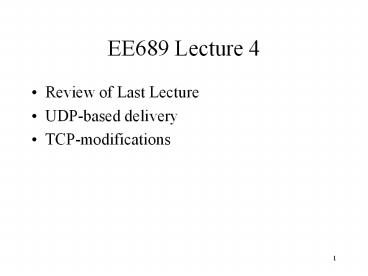EE689 Lecture 4 - PowerPoint PPT Presentation
1 / 27
Title:
EE689 Lecture 4
Description:
Title: EE689 Lecture 4 Author: Steven Woodward Last modified by: Steven Woodward Created Date: 1/26/1999 7:04:42 PM Document presentation format: On-screen Show – PowerPoint PPT presentation
Number of Views:263
Avg rating:3.0/5.0
Title: EE689 Lecture 4
1
EE689 Lecture 4
- Review of Last Lecture
- UDP-based delivery
- TCP-modifications
2
End-to-End Congestion
- UDP-based applications should do end-to-end
congestion control - Otherwise -- BW divided unfairly
- -- Loss of Goodput
- TCP-friendly -- enforce TCP-like control
- Hard to enforce TCP-friendly mechanism
- Multiple connections/IP-spoofing get around those
mechanisms.
3
UDP-based delivery
- Nice Applications will follow end-to-end
congestion - All of the flow control/congestion control
reliability to be built into application. - ALF - Application Level Framing - design
principle - advocates application level of
transport mechanisms.
4
UDP-based delivery
- Packet-pair One mechanism for BW estimation
- Send two packets back-to-back, measure the delay
between acks - ACK Compression - Receiving timestamps
- Round robin scheduling /FIFO
- Minimum ack spacing indicates link BW
5
Cyclic UDP
- Developed at UC Berkeley
- Notion of rounds -- data sent in a fixed size
time units - Retransmit data within the round
- Move on to next round if data not received within
round - Apply flow control within the round.
6
Cyclic UDP
- Prioritize packets within round
- Order higher priority packets in front
- CUDP improves chances of delivery of higher
priority packets -- retransmissions have higher
priority - NACK - indicate not received packets so far on
each packet reception
7
Random vs. Prioritized Loss
8
Cyclic UDP
- Rounds allow timely delivery
- Rounds allow prioritization of current packets
- Application prioritizes within the round
- Uses delay and packet losses for determining
available BW
9
Estimating BW
- Loss rate 1 - bytes recvd/ bytes sent
- Expected loss rate X
- Expected delay D1
- If (L gt X) EstBW (1-L)LtBW/(1X) else if
(meanDelay gt D1)
EstBW (1X)LtBWD1/meanD
elay else EstBW (1X)LtBW
10
(No Transcript)
11
Cyclic UDP
- Adapts to Congestion
- Assumes all available BW can be used
- Not clear what happens to competing TCP
applications - Results indicate multiple CUDP flows share
available BW - Loss rate -- scalability ??
12
Stored Media/Live Media
- Stored Media allows buffering of data, can
tolerate startup delays - More buffering -- more chances of overcoming
congestion/smoother playout - Buffering gt Longer latencies, not acceptable for
interactive applications - Vxtreme etc. exploit buffering
13
CUDP Summary
- Possible to design adaptive flow control into UDP
application - Allows Timely Delivery and discard of expired
packets, prioritization - Shown to scale against CUDP apps.
- Not clear if more aggressive than TCP
- Not a multiplicative decrease response
14
TCP Modifications
- If TCP congestion/flow control is so good, why
not retain it? - Easy to show that TCP-friendly
- Get rid of reliable/in-order delivery mechanisms
that get in the way. - HPF Heterogeneous Packet Flows
15
HPF
- Allows marking packets high/low priority
- Provides In-order reliable delivery of high
priority packets - Allows low priority packets to be delivered when
enough BW available - If routers support priority, can drop low
priority packets ahead of high priority packets
16
HPF Layers
- Application Framing (AF) -- convert frames into
packets, packets into frames - Windowing, Reliability, Timing and Flow-control
(WRTF) -- window management, flow control,
reliability, deadlines - Congestion Control (CC) -- congestion response,
estimation of RTTs
17
HPF Architecture
18
HPF
19
Another Example
20
HPF Sender Interface
21
HPF Receiver Interface
22
HPF
- Separate the reliable delivery from windowing
mechanisms. - Advance rcv_next pointer based on Reliable
packets - Compute fraction of packets lost as opposed to
based on sequence numbers -- a burst of losses
doesnt lead to cwnd being set to 1. - Multiplicative Decrease/Additive Increase
23
HPF Congestion Control
- If ack_fraction gt ?, cwnd fi(cwnd), fi TCP
slow start - If ack_fraction lt ?, cwnd fd(cwnd), fd
1/(1/cwnd 1 - ack_fraction) - ? 1 - random loss probability
24
HPF Performance
25
HPF Priorities
26
HPF - App. Adaptation
27
Summary
- UDP-based delivery puts application in charge to
do flow control, congestion response etc. -- ALF
plus more - Tedious for every application to implement all
the basic mechanisms - Separate ALF policies and implementation -HPF
does this and follows TCP based congestion
response































